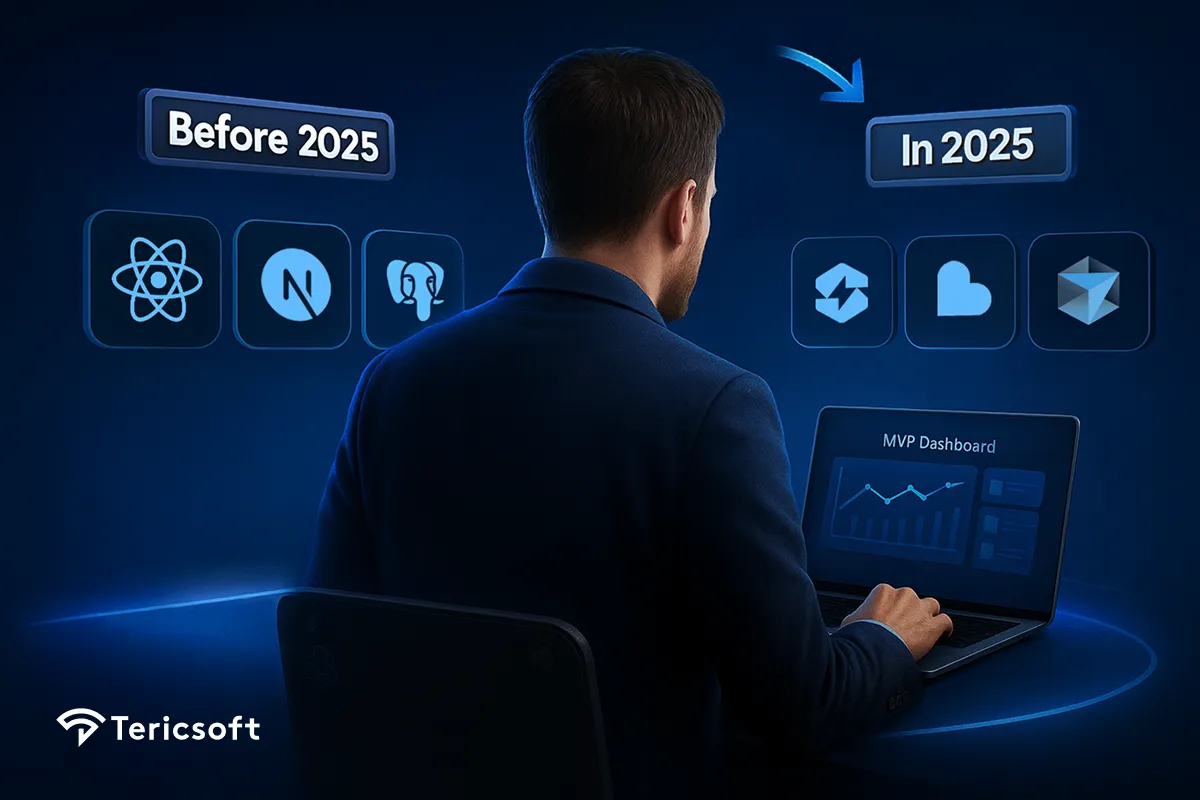
Should you launch your MVP in days using AI-driven 'vibe coding,' or is it a hidden trap of technical debt? Learn why top founders are embracing this rapid prototyping method and discover the critical signals that tell you when it's time to invest in a scalable, custom-engineered solution to ensure long-term success.
Imagine you have a brilliant app idea, one that could change an industry. You're filled with excitement, but also a nagging question: how do you bring it to life? You're standing at a crossroads every modern founder faces. Do you use Al-driven "vibe coding" to build a prototype over a weekend, or do you invest in a team of developers to build it "the right way" from day one?
This isn't just a technical choice; it's a strategic one. Founders constantly grapple with balancing speed and sustainability. You worry that a quick prototype might become "throwaway code," riddled with technical debt that will cost more to fix later. Yet, you can't afford to spend months and thousands of dollars on a product that hasn't been validated.
The good news is, there's a time and place for each approach. This guide is designed to give you a clear, unbiased understanding of vibe coding and custom software development, helping you choose the right path for your product at every stage of its journey.
What is Vibe Coding?
Imagine sitting down to build your app, but instead of opening a code editor, you open a chat window. You don't write lines of Python or JavaScript; you write a sentence in plain English. This is the new reality of vibe coding, a term coined by AI researcher Andrej Karpathy to describe a revolutionary shift in software creation.
This approach is so transformative that Karpathy famously declared:
"The hottest new programming language is English."
- Andrej Karpathy
Source: X (formerly Twitter)
It's a "code first, refine later" philosophy. Instead of meticulously crafting every function, you simply state your intent, or "vibe," like telling an Al to "build me a user login page with Google Auth," and watch as a model like GPT-4 translates your words into working code. This ability to generate functional software at the speed of thought is why the approach has exploded in popularity.
This isn't just a passing trend. It's a powerful method for rapid creation, as evidenced by the fact that 25% of the Winter 2025 Y Combinator batch had codebases that were around 95% Al-generated.
Benefits of Vibe Coding: Why & When It Works
Vibe coding is the founder's ultimate tool for speed. In the early stages, when learning is everything, it allows you to fail, pivot, and iterate faster than ever before.
- Rapid MVP Prototyping: Go from a concept to a functional Minimum Viable Product (MVP) in days, not months. This lets you get real user feedback when it matters most: before you've invested significant resources.
- Extreme Cost-Effectiveness: Vibe coding dramatically lowers the barrier to entry. A solo, non-technical founder can generate a working demo for investors without the immediate need for a full-time development team. One solo founder even built a product with Al that grew to 250,000 users and was acquired for $80 million, showing what's possible.
- Unmatched Iteration Cycles: When user feedback rolls in, you can implement changes almost instantly. This agility is a massive competitive advantage in a fast- moving market.
Limitations of Vibe Coding: Where It Falls Short
Founders rightly fear that a quickly "vibed" MVP can create long term problems. it comes with significant trade-offs that can surface later.
"It might feel 80% done with AI, but that last 20% to make it production-grade can be as hard as starting over."
Source: Reddit
- Technical Debt and Messy Architecture: Al-generated code often lacks the clean, logical structure of human-engineered software. This "spaghetti code" can quickly become a maintenance nightmare, where fixing one bug creates two more.
- Limited Scalability: A vibe-coded prototype is not built to handle high traffic or complex operations. The database might be inefficient, or the architecture might buckle under the load of thousands of users, leading to crashes and slow response times.
- Security Gaps: Al models don't always prioritize security. They might generate code with vulnerabilities or skip essential security practices, putting your user data at risk. This is a non-starter for any serious application.
- The "Throwaway" Factor: This is the hidden cost of vibe coding. You might feel like you're 80% done with Al, but that last 20%, which involves making it secure, scalable, and reliable enough for real customers, can be as hard as starting over from scratch. In many cases, the prototype must be completely rewritten.
What is Custom Software Development?
Custom software development is the traditional, bespoke approach where experienced engineers build your product from the ground up. This method is a strategic investment in quality, control, and long-term success. It's about meticulously designing an architecture that is built to scale, perform, and remain secure as your business grows.
Advantages of Custom Software Development: Building for the Long Game
When your product has proven its value and is ready for growth, custom development provides the solid foundation you need.
- Built to Scale: The architecture is designed from day one to handle increasing user loads and data, ensuring a smooth experience for your customers as you grow.
- Clean, Maintainable Code: A well-structured codebase makes it easier to add complex new features, fix bugs efficiently, and onboard new developers to your team.
- Full Ownership of Intellectual Property: You own the code outright. This is a valuable company asset that gives you complete control and flexibility for the future.
- Rock-Solid Security & Compliance: For apps in fintech, healthcare, or any field handling sensitive data, custom development is non-negotiable. It allows for rigorous security protocols and ensures compliance with regulations like GDPR or HIPAA.
Of course, the primary drawbacks are the higher upfront cost and longer time-to-market. It’s a significant investment, which is why it’s not the right choice for an unvalidated idea.
Direct Comparison: Vibe Coding vs. Custom Development
Here’s a side-by-side look to help you decide which is right for your current stage:
When to Choose Vibe Coding: The Right Scenarios
Vibe coding is the smart choice when your primary goal is learning and validation. It's the perfect tool for building a Minimum Viable Product (MVP), which is designed to test your core assumptions with the least amount of effort.
“Should I quickly vibe-code an MVP or invest in building a scalable product from scratch? I need to get to market fast, but I’m worried about long-term maintainability.”
Source: Reddit
This common concern highlights the strategic value of vibe coding in specific situations:
- Pre-Product-Market Fit: If you're still experimenting with your core idea, vibe coding lets you quickly build a functional version to see if people will actually use and pay for your solution, allowing you to test hypotheses with minimal risk. The goal isn't perfect code; it's validated learning
- Building the Minimum Viable Product (MVP): An MVP is designed to test your most critical business assumption with the smallest possible feature set. Vibe coding is the ideal tool for this, allowing you to build just enough of a product to gather validated learning from real users without over-investing in features that may ultimately be unnecessary.
- Investor Demos: You need a functional proof-of-concept fast. Al can help you build something impressive to showcase to stakeholders in just a few days. The prototype serves as a tangible vision of your product, making your pitch far more compelling.
- Severe Budget Constraints: When you can't yet afford a full development team, vibe coding helps you build something to attract your first users or investors. It's a pragmatic way to get your foot in the door.
If this sounds like your stage, getting expert oversight can help you navigate the process. You can build a smarter, more robust prototype by exploring how Al-powered MVP development can combine the speed of Al with sound engineering principles.

When to Choose Custom Software Development: Signals for Growth
The transition to custom development is a major milestone. Here are the key signals that it's time to invest in a solid foundation:
"If real users rely on your app, the MVP can no longer remain a quick hack. It needs a robust foundation for stability and scalability."
Source: ulam.io
- You've Proven Traction: You have a steady stream of active users, growing revenue, or confirmed investor interest. If real people rely on your app, it can no longer be a quick hack.
- Feature Velocity Stalls: Adding new features or fixing bugs in your prototype has become painfully slow. If every change feels like you're navigating a house of cards, it's time to rebuild.
- You're Hitting Performance Issues: Your app is crashing under load, pages are timing out, and users are complaining about speed. These are classic signs that your initial architecture can't keep up.
- Security & Compliance Become Critical: You are now handling sensitive customer data, processing payments, or operating in a regulated industry. A vibe- coded app is likely too fragile for these demands.
- Investors are Performing Due Diligence: Before a major funding round, savvy investors will scrutinize your tech stack. A professionally engineered product inspires confidence; a hacked-together MVP can be a red flag.
When you see these signs, it's time to bring in the experts. Partnering with a team specializing in custom software development can help you re-engineer your MVP into a stable, scalable application ready for growth.

VibeOps and the Path Forward: A Glimpse into the Future
As vibe coding accelerates development, a new, forward-looking concept is emerging to handle what comes next: VibeOps. This idea extends the principles of Al-driven speed from just writing code to deploying and managing it. VibeOps is about using Al-driven automation across the entire DevOps lifecycle to minimize the friction between rapid development and reliable operations. Think of Al agents that automatically handle testing, deployment, and infrastructure management, creating self-healing systems.
While it's an exciting glimpse into the future, VibeOps is not a silver bullet today. It highlights that even in a world of Al-centric development, human oversight and sound engineering practices, like proper observability and error handling, remain absolutely crucial. For founders, it's a reminder to always plan for operational rigor, no matter how you build your product.
Conclusion: Your Product's Journey from Idea to Scale
There is no one-size-fits-all answer. The most successful founders don't choose one method over the other; they use the right one at the right time.
- Vibe coding is for learning. It's the perfect tool to "build only what you need to learn," test your vision, and find product-market fit with minimal risk.
- Custom development is for lasting. It's the essential investment you make when you have a validated product that needs a solid foundation to grow into a scalable, secure, and reliable business.
Often, the winning strategy is sequential: prototype fast with Al, validate your idea with real users, and then invest in a custom-built solution once you're confident you're on the right track. It's a tough decision, but you don't have to navigate it alone.
Whether you're sketching out your first MVP or planning to scale to millions of users, the right technology partner can provide honest advice and technical support. A true partner is dedicated to helping you succeed, regardless of the path you choose.








